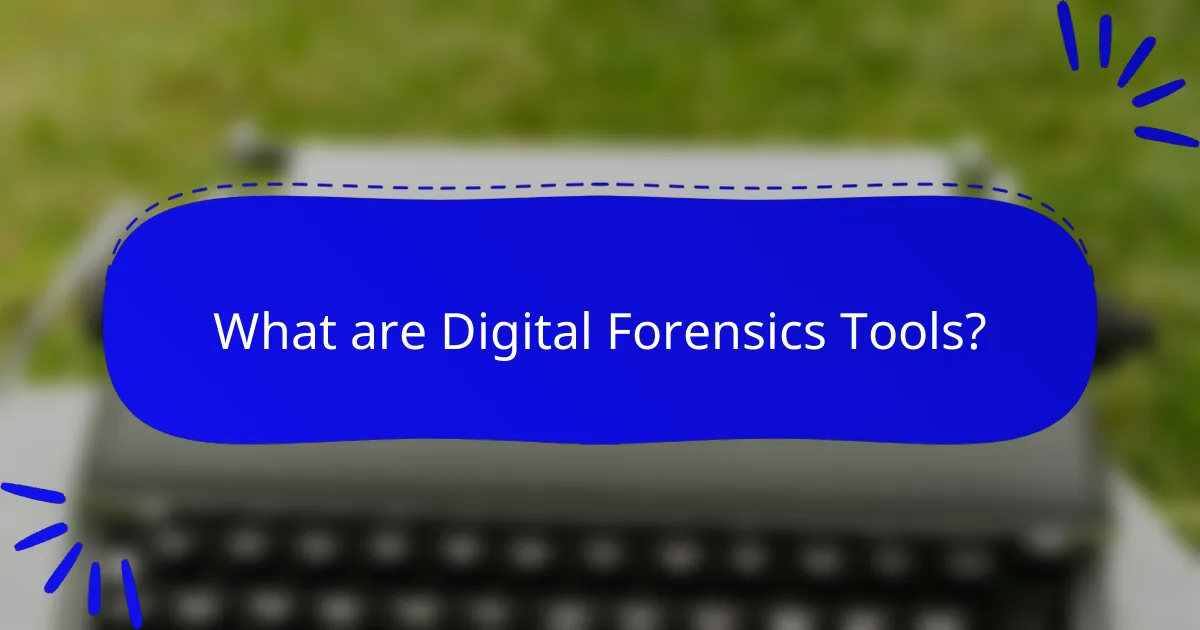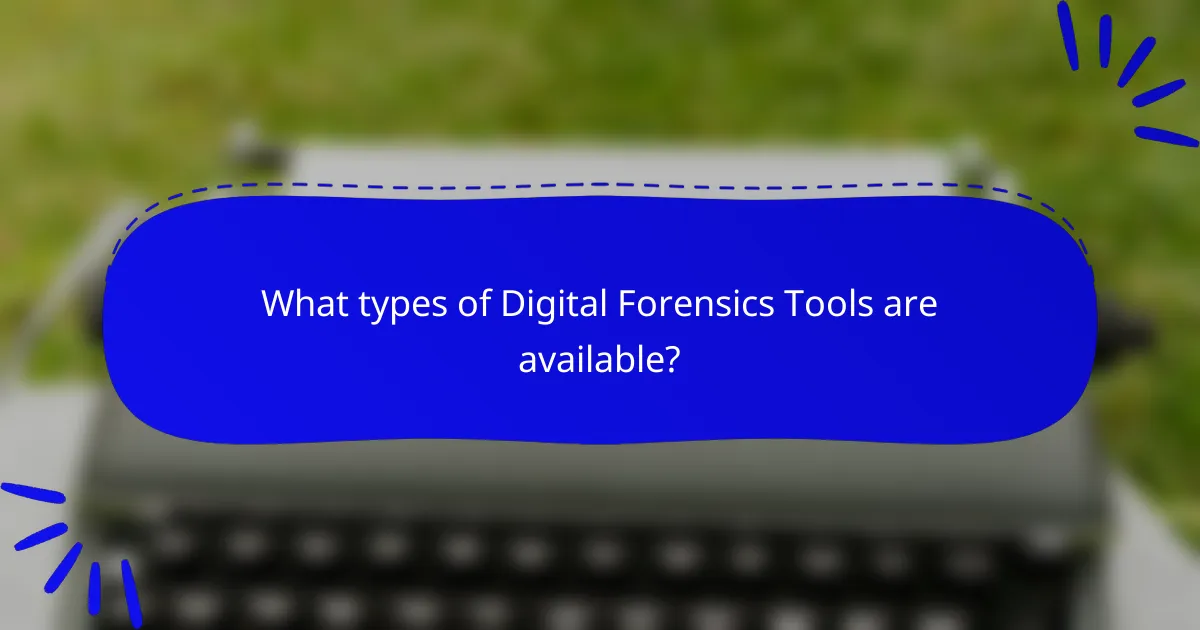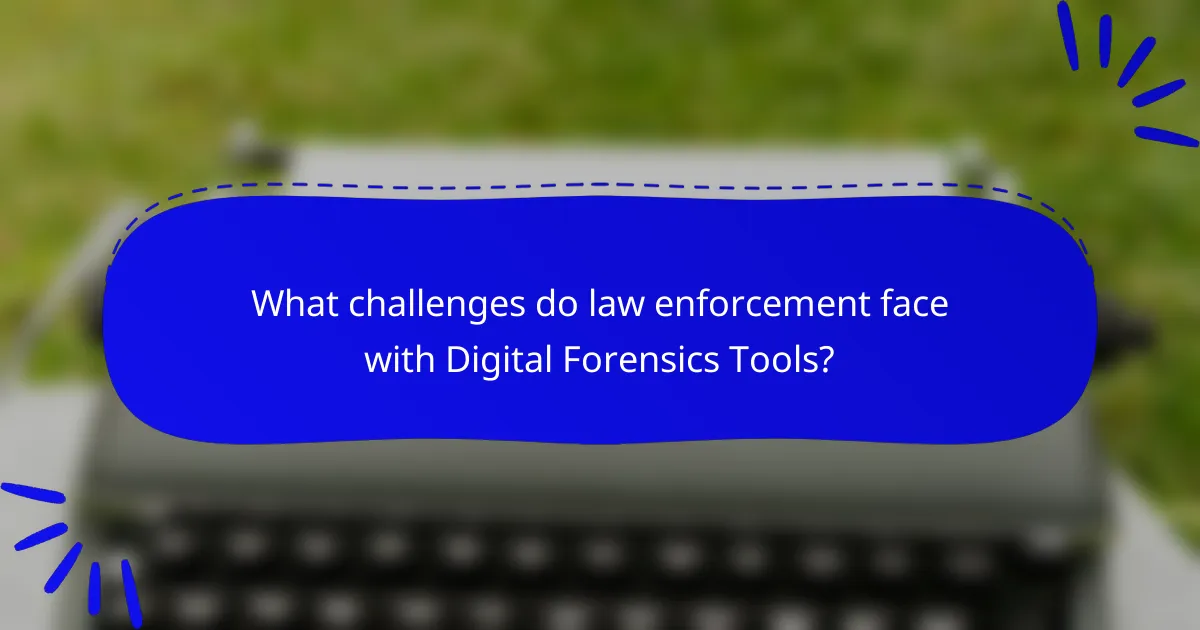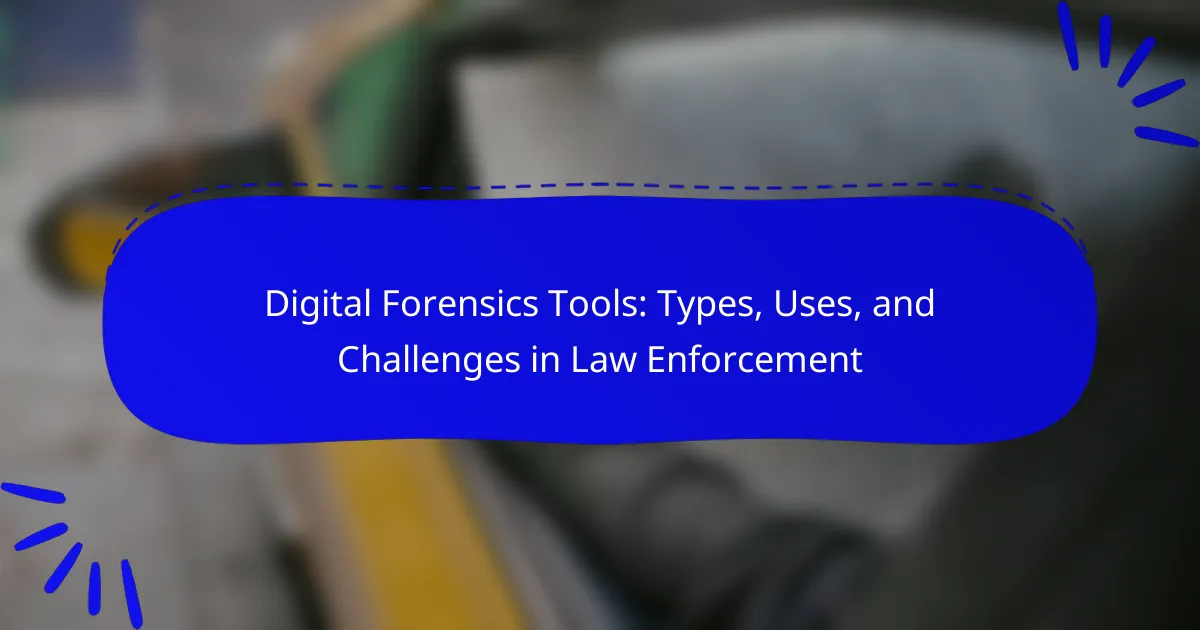
What are Digital Forensics Tools?
Digital forensics tools are software and hardware used to collect, analyze, and preserve digital evidence. These tools assist in investigations involving computers, smartphones, and other digital devices. They help recover deleted files, analyze data patterns, and extract information from various storage media. Common digital forensics tools include EnCase, FTK, and Autopsy. These tools are essential for law enforcement agencies to solve crimes and secure convictions. They ensure that evidence is collected in a forensically sound manner, maintaining its integrity for legal proceedings.
How do Digital Forensics Tools function in law enforcement?
Digital forensics tools function in law enforcement by analyzing digital devices to gather evidence. These tools enable investigators to recover deleted files and examine data structures. They can extract information from various sources, including computers, smartphones, and servers. Tools also help in identifying malware and tracking digital footprints. Forensic software often employs techniques like data imaging and hashing for integrity verification. Law enforcement agencies utilize these tools to support criminal investigations and prosecutions. The effectiveness of digital forensics is demonstrated in numerous cases, such as the use of software like EnCase and FTK in high-profile investigations.
What types of data can Digital Forensics Tools recover?
Digital forensics tools can recover various types of data. They can retrieve deleted files from hard drives and storage devices. This includes documents, images, and videos. They also recover data from mobile devices, such as call logs and text messages. Digital forensics tools can access email accounts and social media data. Furthermore, they can extract metadata from files, providing details about file creation and modification. These tools can also analyze network traffic for evidence of unauthorized access. According to a report by the National Institute of Justice, digital forensics significantly aids in criminal investigations by recovering crucial evidence.
What processes are involved in using Digital Forensics Tools?
The processes involved in using Digital Forensics Tools include data acquisition, analysis, and reporting. Data acquisition involves collecting data from digital devices, ensuring integrity and authenticity. This step often requires creating a forensic image to preserve original data.
Analysis entails examining the collected data for relevant information. Analysts use various tools to recover deleted files, analyze file systems, and examine logs. The goal is to uncover evidence that can support investigations.
Reporting is the final step, where findings are documented in a clear and concise manner. Reports must be understandable to non-technical stakeholders, such as law enforcement officials or juries. Each of these processes is critical to ensure that the evidence is admissible in court and meets legal standards.
Why are Digital Forensics Tools important in investigations?
Digital forensics tools are crucial in investigations because they facilitate the collection, analysis, and preservation of digital evidence. These tools allow investigators to recover data from various devices, including computers, smartphones, and servers. They help in uncovering hidden or deleted files that may be vital to a case. Additionally, digital forensics tools ensure that evidence is handled in a manner that maintains its integrity. This is essential for legal proceedings, as improperly handled evidence can be deemed inadmissible in court. Furthermore, these tools assist in identifying the source of cybercrimes and tracking criminal activities online. The use of digital forensics tools has been shown to significantly improve the efficiency and effectiveness of investigations. According to a study by the International Journal of Digital Crime and Forensics, 70% of law enforcement agencies reported that digital forensics tools enhanced their ability to solve cases.
How do Digital Forensics Tools aid in evidence collection?
Digital forensics tools aid in evidence collection by systematically retrieving and analyzing digital data. These tools can recover deleted files, extract data from devices, and analyze network traffic. They ensure data integrity by creating forensic images, preserving original evidence. Tools like EnCase and FTK are widely used for their ability to process large volumes of data efficiently. Additionally, they provide detailed reporting features that document the evidence collection process. This documentation is crucial for legal proceedings, as it verifies the chain of custody. Studies show that effective use of these tools can significantly enhance the accuracy of investigations.
What role do Digital Forensics Tools play in legal proceedings?
Digital forensics tools are essential in legal proceedings as they help collect, analyze, and present digital evidence. These tools enable law enforcement to recover data from devices like computers and smartphones. They ensure that evidence is preserved in a forensically sound manner. This process is crucial for maintaining the integrity of the evidence in court. Digital forensics tools can uncover hidden files, deleted data, and communication logs. Their findings can support or refute claims made by parties involved in a case. Courts often rely on expert testimony regarding the use of these tools. The reliability of the evidence obtained can significantly influence the outcome of legal proceedings.

What types of Digital Forensics Tools are available?
Digital forensics tools can be categorized into several types. These include disk and data capture tools, which enable the imaging of hard drives and storage devices. File analysis tools help in examining and recovering deleted files. Network forensics tools monitor and analyze network traffic for evidence. Mobile forensics tools are specialized for extracting data from mobile devices. Memory analysis tools examine volatile memory for active processes and data. Each type serves a unique purpose in the digital investigation process, ensuring comprehensive analysis and evidence collection.
What are the main categories of Digital Forensics Tools?
The main categories of Digital Forensics Tools are collection tools, analysis tools, and reporting tools. Collection tools gather data from various digital devices. Examples include disk imaging software and network traffic analyzers. Analysis tools examine the collected data for evidence. These tools can include file recovery software and data carving tools. Reporting tools compile findings into a readable format. They help in presenting evidence in court. Each category serves a distinct purpose in the digital forensics process.
How do hardware-based tools differ from software-based tools?
Hardware-based tools are physical devices used in digital forensics, while software-based tools are applications or programs. Hardware tools include devices like write blockers and forensic duplicators. These tools provide direct access to digital media for analysis. They often offer higher reliability in data acquisition. Software tools, on the other hand, run on computers and analyze data through algorithms. They can perform tasks like data recovery and analysis of file systems. Software tools often require compatible hardware to function effectively. In digital forensics, both types are essential but serve different purposes. Hardware tools ensure data integrity during acquisition. Software tools facilitate deeper analysis of the extracted data.
What are some examples of popular Digital Forensics Tools?
Popular digital forensics tools include EnCase, FTK, and Autopsy. EnCase is widely used for its comprehensive capabilities in data recovery and analysis. FTK, or Forensic Toolkit, is known for its fast data indexing and efficient searching features. Autopsy is an open-source tool that provides a user-friendly interface for digital investigations. Each of these tools is employed by law enforcement for effective evidence collection and analysis. Their popularity stems from their proven effectiveness in real-world forensic investigations.
How do specialized tools enhance Digital Forensics?
Specialized tools enhance digital forensics by increasing the efficiency and accuracy of evidence collection. These tools automate the process of data acquisition, reducing human error. They can recover deleted files and analyze data from various devices. For example, forensic software can extract data from smartphones, hard drives, and cloud storage. This capability ensures that investigators obtain comprehensive evidence. Additionally, specialized tools provide advanced analysis features, such as timeline creation and data visualization. These features help forensic experts identify patterns and connections in the data. Overall, specialized tools significantly improve the effectiveness of digital investigations.
What are the unique features of mobile forensics tools?
Mobile forensics tools have unique features designed for extracting and analyzing data from mobile devices. These tools can recover deleted data, including messages, call logs, and photos. They support a wide range of operating systems, such as iOS and Android. Mobile forensics tools often include capabilities for bypassing security measures like passwords and encryption. They can analyze SIM cards and memory cards for additional data. Many tools provide real-time data acquisition, allowing for immediate analysis during investigations. They also offer reporting functionalities that present findings in a clear, understandable format. Additionally, mobile forensics tools are frequently updated to keep pace with new device models and software updates.
How do network forensics tools support investigations?
Network forensics tools support investigations by capturing and analyzing data from network traffic. They enable investigators to track malicious activities and identify the source of security breaches. These tools can reconstruct user actions during an incident. They provide evidence that can be crucial in legal proceedings. For example, tools like Wireshark allow for packet analysis to uncover unauthorized access. Additionally, they help in monitoring network performance and detecting anomalies. This capability enhances the overall security posture of an organization. The use of these tools is essential in gathering admissible evidence in cybercrime cases.

What challenges do law enforcement face with Digital Forensics Tools?
Law enforcement faces several challenges with digital forensics tools. One major challenge is the rapid evolution of technology. New devices and software emerge frequently, making it difficult for law enforcement to keep up. Additionally, many digital forensics tools require specialized training. This training can be time-consuming and costly for agencies.
Another challenge is the sheer volume of data. Investigators often sift through terabytes of information, which can delay investigations. Moreover, data encryption poses significant obstacles. Encrypted devices may prevent access to crucial evidence.
Legal and jurisdictional issues also complicate the use of digital forensics tools. Different laws govern data access and privacy, impacting investigations. Furthermore, the potential for evidence contamination is a concern. Improper handling of digital evidence can lead to its inadmissibility in court.
Finally, resource limitations hinder the effective use of these tools. Many law enforcement agencies operate with tight budgets, affecting their ability to acquire and maintain advanced digital forensics tools.
What are common obstacles in using Digital Forensics Tools?
Common obstacles in using digital forensics tools include data encryption, which can hinder access to crucial information. Legal constraints may limit the collection and analysis of digital evidence. Additionally, the rapid evolution of technology often outpaces the capabilities of existing tools. Skill gaps among personnel can impede effective tool utilization. High costs associated with advanced tools can restrict accessibility for some agencies. Compatibility issues between different software and hardware can lead to inefficiencies. Lastly, the sheer volume of data to analyze can overwhelm forensic investigators, making thorough examination difficult.
How does data encryption affect Digital Forensics efforts?
Data encryption significantly complicates digital forensics efforts. It protects sensitive information by rendering it unreadable without the appropriate decryption keys. Forensic investigators face challenges in accessing encrypted data during investigations. Encrypted files may prevent the discovery of crucial evidence. According to the International Journal of Digital Crime and Forensics, encryption can hinder the recovery of data in over 60% of cases. Law enforcement may require legal avenues to obtain decryption keys. Without these keys, investigators may not successfully analyze the encrypted data. This limitation can impact the overall effectiveness of digital forensic examinations.
What limitations do Digital Forensics Tools have in handling large data volumes?
Digital Forensics Tools face several limitations when handling large data volumes. These tools often struggle with processing speed, leading to delays in analysis. High data volumes can overwhelm system resources, resulting in crashes or performance degradation. Additionally, data extraction may become inefficient, causing incomplete or corrupted data sets. Storage capacity can also be a constraint, limiting the amount of data that can be retained for analysis. Furthermore, some tools may lack advanced algorithms to efficiently parse and analyze unstructured data. These limitations can hinder timely investigations and affect the overall effectiveness of digital forensics in law enforcement.
How can law enforcement overcome challenges with Digital Forensics Tools?
Law enforcement can overcome challenges with digital forensics tools by implementing continuous training programs. These programs ensure that personnel are updated on the latest technologies and methodologies. Regularly updating software and hardware is essential to maintain compatibility with evolving digital devices. Collaborating with technology experts can provide insights into best practices and innovative solutions. Establishing standardized protocols for evidence handling enhances the reliability of digital forensics. Investing in user-friendly tools can reduce the learning curve for investigators. Additionally, fostering inter-agency partnerships can facilitate resource sharing and knowledge exchange. These strategies collectively enhance the effectiveness of digital forensics in law enforcement.
What best practices should be followed for effective use of Digital Forensics Tools?
Use proper chain of custody to ensure evidence integrity. Maintain documentation of all actions taken with digital evidence. Utilize write-blockers to prevent alteration of original data. Regularly update digital forensics tools to ensure they are effective. Conduct thorough training for personnel on tool usage and protocols. Validate findings through multiple methods to ensure accuracy. Perform analysis in a controlled environment to minimize external interference. Follow legal and ethical guidelines to uphold the integrity of investigations.
How can ongoing training improve the use of Digital Forensics Tools?
Ongoing training enhances the use of Digital Forensics Tools by keeping professionals updated on the latest technologies and methodologies. Regular training sessions improve skill sets, ensuring that users are proficient in utilizing advanced features. This training helps in understanding new software updates and tools that emerge in the field. Furthermore, practical exercises during training foster hands-on experience, which is crucial for effective tool application. Research shows that continuous education leads to a 30% increase in operational efficiency in law enforcement agencies. Ongoing training also promotes adherence to best practices and legal standards, reducing the risk of errors in investigations. This combination of knowledge and practical application ultimately leads to more accurate and reliable forensic analyses.
What future trends are emerging in Digital Forensics Tools?
Future trends in digital forensics tools include increased automation and artificial intelligence integration. These advancements enhance data analysis speed and accuracy. Cloud forensics is also gaining traction due to the rise of cloud storage solutions. Mobile device forensics continues to evolve with more sophisticated extraction techniques. Furthermore, cross-platform compatibility is becoming essential for forensic tools to analyze diverse operating systems. The emphasis on cybersecurity measures in forensics is growing as threats increase. Blockchain technology is being explored for ensuring data integrity in investigations. Lastly, collaboration between law enforcement and private sector firms is expected to strengthen tool development and innovation.
How is artificial intelligence influencing Digital Forensics Tools?
Artificial intelligence is significantly enhancing digital forensics tools. AI algorithms improve data analysis speed and accuracy. They can process large volumes of data quickly. This capability reduces the time needed for investigations. AI also assists in identifying patterns and anomalies in data. Machine learning models can predict potential security breaches. Additionally, AI tools automate repetitive tasks, allowing forensic experts to focus on critical analysis. Research indicates that AI-driven tools can increase the efficiency of digital investigations by up to 50%. These advancements are reshaping how law enforcement approaches digital evidence collection and analysis.
What advancements are expected in Digital Forensics technology?
Advancements in Digital Forensics technology are anticipated to enhance data recovery and analysis capabilities. These improvements include the integration of artificial intelligence for faster data processing. Machine learning algorithms will help identify patterns and anomalies in large datasets. Enhanced encryption-breaking tools are also expected to emerge. These tools will assist in accessing secured data more efficiently. Additionally, advancements in cloud forensics will allow for better investigation of data stored in cloud environments. The development of mobile forensics tools will cater to the increasing use of smartphones in criminal activities. Finally, improvements in blockchain analysis will aid in tracing cryptocurrency transactions. These advancements are driven by the need for more effective law enforcement responses to digital crimes.
What tips can enhance the effectiveness of Digital Forensics Tools?
To enhance the effectiveness of Digital Forensics Tools, ensure proper training for personnel. Skilled users can maximize tool capabilities and interpret results accurately. Regularly update software to protect against vulnerabilities and improve functionality. This practice aligns with cybersecurity standards. Implement standardized procedures for evidence collection and analysis. Consistency reduces errors and increases reliability. Utilize multiple tools for cross-verification of data. This method strengthens findings and mitigates tool-specific biases. Document all processes meticulously to maintain chain of custody. This ensures legal compliance and enhances the credibility of findings.
Digital forensics tools are specialized software and hardware utilized in the collection, analysis, and preservation of digital evidence from devices such as computers and smartphones. This article explores the various types of digital forensics tools, their functions in law enforcement, and the processes involved in using them effectively. It also addresses the challenges faced by law enforcement agencies, including data encryption and the rapid evolution of technology, while highlighting the importance of ongoing training and advancements in the field. Key tools such as EnCase, FTK, and Autopsy are discussed, along with emerging trends like artificial intelligence integration and cloud forensics.
